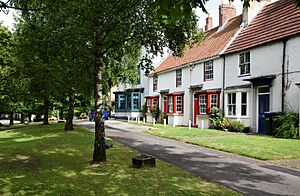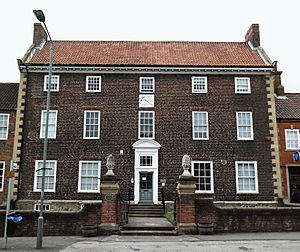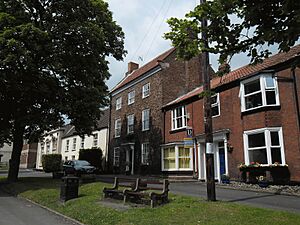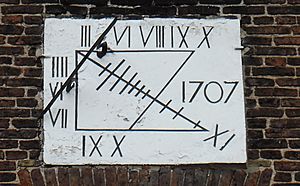Sedgefield facts for kids
Quick facts for kids Sedgefield |
|
|---|---|
 Houses on The Square |
|
| Population | 5,211 (2011) |
| OS grid reference | NZ354286 |
| Civil parish |
|
| Unitary authority |
|
| Ceremonial county | |
| Region | |
| Country | England |
| Sovereign state | United Kingdom |
| Post town | STOCKTON-ON-TEES |
| Postcode district | TS21 |
| Dialling code | 01740 |
| Police | Durham |
| Fire | County Durham and Darlington |
| Ambulance | North East |
| EU Parliament | North East England |
| UK Parliament |
|
Sedgefield is a lively market town in County Durham, England. In 2021, about 4,986 people lived there. It's special because it has the only horse racing track in County Durham!
Contents
What's in a Name?
The name Sedgefield comes from old English words. It means 'Cedd's field,' named after someone called Cedd.
A Look Back in Time
Roman Discoveries
In 2003, a cool Roman settlement was found near Sedgefield. It was discovered by the TV show Time Team. This ancient village had rows of small farms and workshops. They were set up like a ladder along a north-south road. Roman coins helped experts figure out how old it was.
Hunting History
In the 1800s, Sedgefield was a big center for hunting. People even called it 'the Melton of the North'. A famous hunter named Ralph Lambton had his main base here. The writer Robert Smith Surtees was his friend and often visited.
Winterton Hospital's Past
Sedgefield was also known for Winterton Hospital. This hospital was once a large place for people with illnesses or mental health needs. It was like its own small village, with a fire station, a bank, and even a cricket team! Today, most of the hospital is gone. Only the old church remains, surrounded by new houses and a science park called NETPark.
Important Buildings and Places
St Edmund's Church

The church of St Edmund was first started around the year 900. The Normans later built a stone church with round arches. The church you see today was mostly built between 1246 and 1256. The tall tower was added in the 1400s. Inside, you can see beautiful old wooden carvings.
Ceddesfeld Hall
Ceddesfeld Hall used to be the home of the local church leader. It was rebuilt in 1793 by the Barrington family for their nephew. Today, it's used by the Sedgefield Community Association. There's a Latin message above the door. It praises Samuel and Shute Barrington, who helped rebuild the hall. The gardens around the hall are now a public park.
The Manor House
The Manor House is a grand building at the top of the village green. It has three floors and is a great example of Queen Anne style architecture. It was built in 1707. For many years, it was used as offices for the local council and later as a court. Now, it's a popular place for weddings and events.
Hardwick Hall
Hardwick Hall is a historic estate near Sedgefield. In the 1700s, an architect named James Paine started designing a large estate here. The work was never fully finished, but the beautiful grounds became Hardwick Hall Country Park. The park is a very important historical garden. The main building is now the Hardwick Arms Hotel.
How Sedgefield is Run
Sedgefield has a local mayor. It is also part of a larger area called an electoral ward. This ward includes nearby areas and had about 6,879 people living there in 2011.
The Parish Hall
The Parish Hall started in 1849 as a place for literature and science. It was later rebuilt. In 2008, it was updated and now hosts many social events and fun activities for the community.
Learning in Sedgefield
Sedgefield has two primary schools: Sedgefield Hardwick and Sedgefield County Primaries. For older students, there is Sedgefield Community College.
Local Life and Traditions
Sedgefield is connected to Hamminkeln, Germany, as a twin town. In 2012, the town celebrated 700 years since it was allowed to hold a market. The market used to be held on Cross Hill. Now, a farmers' market takes place on the first Sunday of every month. Sedgefield also has a friendship with Duisburg-Rheinhausen in Germany.
Yearly Events
A special event called the Sedgefield Ball Game happens every Shrove Tuesday. It's a type of traditional 'mob football' game. A statue was put up to remember this yearly event.
Another popular event is the Mediaeval Fair in mid-May. The main streets of Sedgefield are closed for it. People can enjoy fun fair rides and activities that are like those from medieval times.
News and Media
Local news and TV shows for Sedgefield come from BBC North East and Cumbria and ITV Tyne Tees. You can also listen to local radio stations like BBC Radio Tees and Capital North East. The local newspaper is The Northern Echo.
Getting Around
Sedgefield railway station opened in 1835 but closed in 1952. Today, you can still get around using public transport. The Arriva North East X22 bus route runs every hour. It connects Sedgefield to Peterlee and Middlesbrough.
Sports and Activities
Sedgefield has many places and groups for sports.
Horse Racing
The most famous sports venue is Sedgefield Racecourse. Horse races have been held here since 1732. Official races started in 1846.
Cricket
Sedgefield Cricket Club is located on Station Road. The land was given to the town around 1900. Many adult and junior teams play here.
Rugby
Sedgefield District RUFC was started again in 2007. They are a small club based at the cricket club. They have their own pitch with great views. The club is known for being very welcoming to other teams and officials. Their first team plays in the Durham/Northumberland 2 league. They have won promotions and county trophies. The second team, the "Sedgefield Saxons," helps new players develop their skills.
Motocross
Quad Sport Leisure is a place where people can ride quad bikes off-road. It started in the late 1970s. It's one of the few places in the North East where you can legally ride quad bikes. They have tracks for all ages, and you can even rent quads. There's also a special track for experienced riders with their own quads.
Squash
Sedgefield Squash Club has two courts behind Ceddesfeld Hall. One court has a glass wall. The club has many men's and ladies' teams that play in local leagues. There are also many junior members. The club was updated in 2020-2021.
Football
Sedgefield Youth Football Club (SYFC) has an Under-12 team. They play in the Teesside junior football league. Their home is at the local community college. Sedgefield ST Edmunds F.C also plays in a local league.
Tennis
Sedgefield Tennis Club plays on three courts at the Community College. The club has ladies', mixed, and men's teams that play in the Cleveland Tennis League.
Golf
Knotty Hill Golf Centre is a large golf course with 45 holes. It opened in the mid-1990s. It has two 18-hole courses and a 9-hole academy course.
Running
Sedgefield Harriers is a local running and athletics club. They are based at Sedgefield Community College. Members compete in road races, cross country, and track events. The club has a large junior section. They host several races throughout the year. In 2011, the club was named National Development Club of the Year. In 2020, they announced plans for a new athletics track.
Famous People from Sedgefield
- John Blakiston – A Member of Parliament.
- Stan Cummins – A footballer who played for Middlesbrough and Sunderland.
- Aidan Davison – A footballer who played for Northern Ireland.
- Dave Hockaday – A footballer and coach.
- Thomas H. McIntosh – A football manager who led Everton to win the FA Cup and league titles.
- Vaughan Oliver – An artist and graphic designer.
- Bradley Saunders – A professional boxer.
- Jack Smith – A gold medal-winning wheelchair rugby athlete.
- Peter Willey – A former cricketer and umpire.





